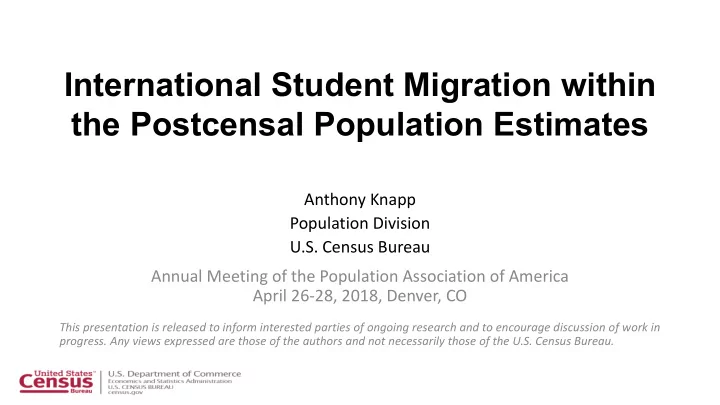

International Student Migration within the Postcensal Population Estimates Anthony Knapp Population Division U.S. Census Bureau Annual Meeting of the Population Association of America April 26 ‐ 28, 2018, Denver, CO This presentation is released to inform interested parties of ongoing research and to encourage discussion of work in progress. Any views expressed are those of the authors and not necessarily those of the U.S. Census Bureau.
Introduction International student migration has been increasing over time: Global total < 2 million in 1999. 4.7 million in 2015 (UNESCO) United States is the largest receiving country (UNESCO) Enrollment in United States exceeded 1 million in 2015/2016 (IIE 2016) United States government administrative data on student migration: Student visa admissions (Office of Immigration Statistics) Student visas issued abroad (Bureau of Consular Affairs) Type of educational program (Immigration and Customs Enforcement) Impact on United States resident population estimates is unknown. Difficult to identify in censuses and surveys because students can also be included in other migrant categories (e.g. labor migration). 2
Measuring International Students How to identify international students? Examples: Citizenship status Intent/reason for moving Legal status (e.g. cannot establish legal permanent residence) Enrolled in an academic program Who to include in population and migration statistics? Census residence rules are not equivalent to legal residence. Based on intended or actual duration of stay rather than immigration status. Individual entries into the country are not the same as migration events. Census Bureau immigration estimates rely on survey data instead of administrative records. 3
Census Bureau, Population Estimates Program (PEP) PEP produces official population estimates for the United States based on natural increase and net migration. PEP estimates annual foreign ‐ born immigration as a subcomponent of net international migration: Foreign ‐ born immigration reflects the number of non ‐ US citizens and naturalized citizens whose residence one year ago was abroad. Apply population characteristics of recent arrivals ( proxy universe ) from multiple survey years to estimate demographic composition and geographic distribution of foreign ‐ born immigration. However, PEP does not consider student status when producing estimates. 4
Research, Data, and Methods Research Questions: What impact does international students have on immigration statistics used to produce population estimates? How do migration levels and demographic characteristics of students compare to non ‐ students and how has this comparison changed over time? How does the geographic distribution of students within the United States differ from non ‐ students? I simulate foreign ‐ born immigration from Vintage 2017 PEP estimates. I modify the proxy universe to include enrollment status: non ‐ student, primary/secondary (grades K ‐ 12), and tertiary (college or higher). 5
Annual Estimates of Foreign-Born Immigration by Enrollment Status: 2010-2017 Simulation of V2017 foreign ‐ born immigration time series. Student immigration increased 42% from 0.34 in 2010 to 0.48 million in 2017. Non ‐ student immigration increased 35% between 2010 and 2017. Students comprise about 1/3 of total foreign ‐ born immigration. Tertiary students comprise about 1/2 of students. Data source: Census Bureau, Population Division, Simulated 2017 Estimates. 6
Foreign-Born Immigration by Age Group, Sex, and Enrollment Status: 2010 and 2017 Data source: Census Bureau, Population Division, Simulated 2017 Estimates. 7
Foreign-Born Immigration Age 18 to 24 by Sex, Race, Hispanic Origin, and Enrollment: 2017 Student Non ‐ Student Note: Categories are non Hispanic unless otherwise stated and are mutually exclusive. Race categories are the following: White alone, Black or African American alone, American Indian or Alaska Native (AIAN) alone, Asian alone, Native Hawaiian or Other Pacific Islander (NHPI) alone, and Two or more races. 8 Data source: Census Bureau, Population Division, Simulated 2017 Estimates.
Age Distribution of Foreign-Born Immigration for Non-Students, Primary/Secondary Students, and Tertiary Students: 2010 and 2017 Note: Proxy universe method inflates student numbers at earlier ages. 9 Data source: Census Bureau, Population Division, Simulated 2017 Estimates.
Annual Estimates of Foreign-Born Immigration by Enrollment Status: 2010-2017 Time series comparison of simulation and external data. Institute of International Education (IIE): Open Doors report, new international enrollment Excluding students enrolled in non ‐ degree programs Simulation: tertiary students. Data sources: Census Bureau, Population Division, Simulated 2017 Estimates and 10 IIE Open Doors 2017.
State Distribution of Foreign-Born Immigration by Enrollment Status and Census Region: 2017 Non ‐ Student Primary/Secondary Tertiary 175,000 (approx.) Data source: Census Bureau, Population Division, Simulated 2017 Estimates. 11
Tertiary Students as percent of State Foreign-Born Immigration: 2010 and 2017 International students enrolled in college or higher. % tertiary students did not change much between 2010 and 2017. % tertiary students higher for most states in 2010 compared to 2017. Lower percentages for Florida (10%), New Jersey (10%), and Texas (12%). Higher for Massachusetts (21%). Data source: Census Bureau, Population Division, Simulated 2017 Estimates. 12
Percent of Foreign ‐ Born Immigration since 2010 that are Tertiary Students Data source: Census Bureau, Population Division, Simulated 2017 Estimates. 13
Discussion Evaluation of the Vintage 2017 estimates based on international student migration: Simulation of students relies on ACS residence rules and available variables. About 1/3 rd of annual foreign ‐ born immigration estimates are students and half of these are tertiary students. Peak migration age 18 ‐ 24 is increasingly students. Student migration concentrated in a few, but expected, geographies. Impact to total resident population? Assumptions on how many students return home after study. Do they stay in the United States or do they leave? Internal migration to other counties/cities in the United States after graduation? 14
Recommend
More recommend